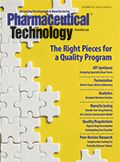Residual Moisture Determination in Lyophilized Drug Products
The author provides an overview of common residual moisture methods for lyophilized drug products and key points to consider during method selection and method development.
MR.ILKIN/STOCK.ADOBE.COM
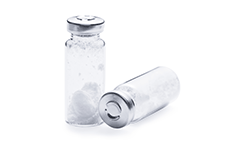
Lyophilization is a common step in drug product manufacturing to improve stability of the formulation. Optimization of the lyophilization cycle for each formulation/fill combination includes assessment of the residual moisture level of the lyophilized cake. Residual moisture is a critical parameter for stability of the API in lyophilized drug products, particularly with large-molecule formulations such as monoclonal antibody (mAb) and other protein formulations. Often a minimum moisture level is required for protein structural integrity; however, a maximum moisture limit is implemented to reduce API degradation and ensure elegant cake appearance over time. It is imperative that a suitable moisture method is developed for each product to ensure accurate monitoring of the moisture level.
Several methods are commonly used in the pharmaceutical industry for residual moisture determination of lyophilized drug products. Methods range from simple drying of samples (loss on drying [LOD]) to titrations (Karl Fischer [KF]) to complex spectroscopic techniques (near infrared spectroscopy [NIR]). Factors such as sample interference, method accuracy, method range, and ability for non-destructive measurement must be considered when choosing an appropriate method for each product. The intent of this article is to provide an overview of common residual moisture methods for lyophilized drug products and discuss the key points to consider during method selection and method development.
Importance of residual moisture
Drug product formulations for many types of molecules are not stable in aqueous solution and often require refrigerated or frozen conditions or the addition of excipients to prevent degradation. Protein and mAb formulations are particularly susceptible to aggregation, deamidation, oxidation, and other degradation pathways not only in solution, but as freeze-dried solids. Residual moisture acts as a plasticizer in predominantly amorphous systems and lowers the glass transition temperature, Tg, of the formulation (1). Even relatively small changes in residual moisture can lead to significant changes in both physical stability and solid-state chemical stability. These types of degradation are more likely to occur with higher levels of water in the formulations; therefore, lyophilization is an appropriate processing step to remove moisture from the formulation.
In the lyophilization process the solution is frozen, then a high percentage of water is removed through sublimation of the ice under low pressure during the primary drying process. This is followed by the secondary drying process, during which the product temperature can be increased to remove additional water to meet moisture level specifications. Optimization of the lyophilization cycle is required to achieve acceptable cake appearance and reconstitution time without comprising the drug activity and stability. Some residual moisture remains in the drug product after lyophilization and must be measured and monitored as part of lyophilization secondary drying process development, product characterization, and stability studies.
While low residual moisture levels may seem ideal to prevent degradation, an intermediate level of residual moisture may be needed to ensure acceptable protein activity and reconstitution of the sample (1). Too low residual moisture may cause aggregation, loss of protein activity, reconstitution issues, or even impact further processing steps such as viral inactivation for safety purposes (1,2). The ability to determine the residual moisture of drug products with acceptable accuracy and precision is crucial for product characterization and stability to ensure the moisture levels remain within the desired range of values. Water may be present in lyophilized samples as bound (absorbed), surface (adsorbed), or trapped (1,3,4). Use of different methodologies for residual moisture analysis may yield variable results depending on which type of water is being measured. Typically, residual moisture for lyophilized drug products reflects the amount of surface water present (1,4).
Compendial moisture methods
Standard-setting organizations such as the US Pharmacopeial Convention (USP) include chapters for well-established moisture methods that are routinely used for residual moisture determination in lyophilized drug products (Table I). While these methods are well-established techniques, they still must be assessed for specificity, accuracy, linearity, precision, and range for products labeled as meeting good manufacturing practice (GMP) requirements.

Loss on drying (LOD) is the simplest and oldest technique for residual moisture analysis and may be performed without any specialized laboratory equipment. The sample is removed from the vial and weighed into a dried container. The sample is dried using heat, vacuum, or desiccant to remove moisture, then it is cooled and reweighed. The amount of moisture present is calculated by dividing the weight lost during drying by the original weight (5). While this method is simple, it lacks the accuracy and specificity required for most applications. The loss on drying test yields the amount of weight lost only and is not specific for water.
Larger sample amounts are needed than with other methods, which can require multiple vials for low-fill products. Other volatiles in the product such as ethanol may also be driven off, yielding inaccurate results. Sample degradation may occur with higher temperatures, which may contribute to falsely high results particularly with proteins. Incomplete drying of samples may yield falsely low results.
The technique is very sensitive to test conditions, such as how sample containers are dried and stored, how quickly and uniformly the sample is prepared, how the sample is cooled after drying, and how quickly measurements are obtained after drying to prevent ambient humidity contamination. Test conditions can be especially critical for hygroscopic samples or high humidity laboratories. These factors all contribute to poor accuracy and reproducibility when compared to other methods.
Thermogravimetric analysis (TGA) is a similar technique to LOD, but with the advantage of being able to use a smaller sample size and having improved control over weighing and temperature. The sample is removed from the vial and weighed into an analysis pan inside a low humidity glove box. The analysis pan is sealed for transfer to a commercially available instrument, which is comprised of a programmable oven and microbalance (6). The weight of the sample is continuously monitored while the temperature is increased from ambient to a temperature that will drive off water without degrading the sample.
Similar to LOD, method development is required to determine the appropriate temperature and time required for the sample to reach a constant weight and moisture cannot be distinguished from other volatiles that may evolve at lower temperatures. TGA may be combined with other techniques such as mass spectrometry to differentiate which transitions are due to residual moisture and which are related to other volatiles (1). Drawbacks of TGA include the need to open the sample vial and lack of specificity for water.
Karl Fischer (KF) titration was first developed in 1935 (7) and is based on the generation of electrons during the reaction of iodine and water, as follows (8).
Alcohol (typically methanol) and sulfur dioxide mix in a basic solution (typically imidazole) (Equation 1):
ROH + SO2+ RN → (RNH)·SO3R
[Eq. 1]
Iodine is generated electrochemically by the instrument through anodic oxidation of iodide in the solution (Equation 2):
2 I- → I2 + 2e-
[Eq. 2]
The iodine reacts with water in the sample. Once all water has reacted with iodine, the generation of iodine stops and the titration ends. The amount of water present is determined by measuring the current and duration of the reaction (Equation 3).
(RNH)·SO3R + 2RN + I2 + H2O → (RNH)·SO4R + 2(RNH)I
[Eq. 3]
Measurement of residual moisture in lyophilized products is usually performed using coulometric KF titration, per United States Pharmacopeia (USP) <921>, Method Ic (9). KF analysis may be performed using manual titration but is most commonly performed using commercially available instrumentation. Commercial reagents and standards are also available, which allow for easy implementation in quality control (QC) laboratories, operation by entry-level scientists, and consistency between laboratories. Coulometric titration is preferred over volumetric titration because lower moisture readings are more accurate and reproducible using this technique.
In coulometric KF titrators, iodine is generated electrically from iodide in the KF reagent when the drift in moisture measured is above a defined threshold. Once the drift drops below a setpoint due to all the water in the system reacting with the free iodine, the instrument stops producing iodine and the titration reaches the endpoint. For volumetric KF titration, the iodine is delivered from a buret as needed, and the solution is standardized for calculation of the residual water in the sample (7). Coulometric KF instruments are available with or without a diaphragm to separate the anode and cathode.
Instruments without a diaphragm require only one reagent and reduction of iodine back to iodide at the cathode is prevented by the design of the instrument. Instruments with a diaphragm require separate anolyte and catholyte reagents for operation and are preferred for very low levels of moisture typically found in lyophilized drug products, as reactions reach the endpoint more quickly, and the instrument is more accurate and precise at lower levels.
Lyophilized samples may be analyzed by direct addition to the titrator or by external extraction using an anhydrous solvent. Typically, extraction using anhydrous methanol is the preferred method because the drug product sample container has minimal exposure to the laboratory environment and methanol is compatible with the KF reaction. Direct addition of the sample to the titrator requires opening the product vial, transferring material to weigh on a balance, and then opening the KF titrator to add the sample. These steps all allow for environmental moisture contamination of the measurement.
External extraction requires analysis of a blank measurement to subtract the diluent moisture content from sample results, but substantially reduces exposure of the sample to the environment. Anhydrous methanol is transferred to a stoppered container to reduce gradual increase of moisture in the diluent during the test duration. Lyophilized samples are generally stoppered with partial vacuum in the headspace, which can impact the accuracy of the weighed vial; therefore, any vacuum in the sample container is released using a dry syringe needle prior to weighing. Syringes and needles are used to reconstitute the lyophilized sample with anhydrous methanol, and the sample is mixed by vortex mixing or sonication to dissolve or suspend the cake solids.
Both the weight of the lyophilized cake and the diluent added must be determined. The reconstituted solution is analyzed by KF, and then the moisture content of the cake is calculated by subtracting the diluent moisture level. Duplicate or triplicate analysis of samples is recommended to ensure reproducible results. Common issues during KF analysis include sample interference and sample dissolution difficulties. Many drug product formulations include excipients or active ingredients that interfere with the KF reaction, such as reducing agents like ascorbic acid which react with the iodine in solution or boron compounds like boric acid which react with the methanol to yield water (7, 10). Both types of interference yield artificially high moisture results.
Performance of spiking studies to determine accuracy and linearity are essential in verifying that no side reactions are occurring that may artificially inflate results. While complete dissolution of the cake in the extraction solvent is not required for reliable, accurate results, incomplete dissolution can result in lower moisture values, clogged syringes, and poor precision. The diluent may be modified to include other reagents, such as formamide for sugars, sugar alcohols, and proteins, which may improve dissolution. Interference due to the presence of ketones or aldehydes in the sample may be overcome using special KF reagents that contain different alcohols or increasing the pH (7).
Sample interference may often be overcome using KF instruments with an oven attachment. With an oven, the sample is heated, and moisture is driven into the titrator via dry air or nitrogen so that the sample never directly contacts the KF reagent. Because only the moisture is titrated, side reactions are often eliminated. Use of a KF Oven instrument does require the development of appropriate settings for oven temperature, run time, and endpoint criteria, but enables moisture analysis using a well-established and accepted technique.
Use of KF Oven typically requires opening the sample vial to transfer weighed material to an analysis vial, and so use of a low humidity glove box is recommended, and determination of a method blank is important. Overall, coulometric KF has many benefits and is usually a first-choice method for residual moisture analysis. Tedious manual analysis, use of hazardous reagents, and destruction of the sample are the main drawbacks of this method.
Spectroscopic methods such as near infrared spectroscopy (NIR) have more recently been adapted for residual moisture determination of lyophilized products. The main reason for the popularity of these types of methods is that they enable lyophilized samples to be analyzed non-destructively. Lyophilized samples typically are produced in glass tubing vials which have a flat bottom surface. The spectrum of the cake is read through the bottom of the vial and correlated to the known moisture result using chemometric software. Moisture determination by NIR uses two regions of water absorption: the OH stretch/HOH bend combination band at approximately 5150–5200 cm-1and the first overtone of OH stretch at approximately 6800–6940 cm-1(11).
The NIR absorption is not a direct measurement of water content. Instead, a calibration curve must be generated using a reference method such as KF, and the KF moisture values are correlated to the NIR spectra. Lyophilized vials spanning the desired region of residual moisture levels are first scanned using the NIR to obtain the spectrum. Then the same vials are analyzed using a reference method such as coulometric KF to obtain the residual moisture. The residual moisture values are then entered into the NIR chemometric software to correlate the values for each vial and create a calibration curve.
Several options for correlation are available, including stepwise multiple linear regression (SMLR), partial least square (PLS), and principle component regression (PCR), with PLS being the most commonly used method. The second derivative of the spectrum is used for quantitative analysis. Once the calibration has been created, the correlation must be evaluated for acceptable fit. The coefficient of determination (R2), root mean square error of calibration (RMSEC), and other software specific values such as Performance Index are useful to assess a good calibration curve (11). Settings for smoothing, minor adjustments for the spectral regions, and removal of outlier values may aid in creating a good calibration. At least 20 independent values are required to provide sufficient data for the correlation.
Once a suitable calibration is obtained, a cross-validation is typically performed to further assess performance. One standard is removed from the model at a time, re-calibration is performed, and predicted values are generated. Cross-validation will yield the R2 of cross validation and root mean square error of cross validation (RMSEV), which are useful in comparing calibrations to find the optimal model. Additionally, more lyophilized samples may be scanned by NIR, analyzed by KF, and then predicted results are compared to the KF result. This external cross-validation allows calculation of the root mean square error of prediction (RMSEP) (11).
Drawbacks for this type of method include shifting or shrinkage of the cake within the vials resulting in error in obtaining the spectra, necessity of calibration curve creation for each formulation, needing to validate the chemometric software, and potentially missing moisture in the vial headspace. The laser for NIR systems typically reads about 3–4 mm into the cake, through the glass vial. If the cake does not contact the vial surface, the reading will not be as accurate. Furthermore, lyophilized samples with very low fill volumes may not be suitable if the cake is too thin. Having a cake of “infinite thickness” or more than 4 mm eliminates the need to consider depth of the reading into the sample (12).
As described previously, development of NIR methods requires correlation to a direct method, and the reference method must first be validated prior to supporting NIR calibration creation. Within a standard chemometric software there are many mathematical tools to analyze and fit the correlation data, and achieving acceptable correlation may be difficult. Large sample sizes are required, and samples must be available that span the range of anticipated moisture results. Preparing lyophilized samples across a wide residual moisture range may be difficult, because cake meltback may occur at higher moisture levels and spiking samples with water requires care not to dissolve the cake and to ensure moisture is fully equilibrated throughout the cake prior to NIR measurement. Because other components in a formulation, particularly sugars, may yield changes in the NIR spectrum, a new calibration model must be developed for each formulation (11).
Chemometric software packages are now available that meet 21 Code of Federal Regulations (CFR) Part 11 requirements, but completing such a validation takes time and resources. Despite these drawbacks and the need for more upfront work, NIR is a useful technique, especially when large numbers of samples must be analyzed, or sample quantities are limited and non-destructive testing is desired.
Emerging techniques
New techniques for moisture measurement continue to be developed. One such instrument is the Vapor Pro Moisture Analyzer manufactured by Ametek (Rx and XL models), which has been evaluated in the lab as an alternative to KF or LOD, especially for samples that are not compatible with the KF reaction or include other volatiles. The lyophilized cake is broken up using a sharp probe by piercing the stopper and is then placed into the heated chamber of the instrument. As the vial is introduced into the instrument, the stopper is pierced by a hollow needle so that dry nitrogen can flow through the sample as it is heated. Moisture is driven off and measured by a calibrated relative humidity sensor. Sensor readings are combined with nitrogen flow and temperature data to yield the sample moisture result.
Advantages of the system are that no hazardous reagents are required, most side reactions found in KF titration are eliminated, measurement are specific for moisture, lyophilized sample vials do not need to be opened prior to analysis, and the system may be used by operators with minimal training. Drawbacks of this technique are the need for method development to optimize temperature and analysis time, destruction of the sample, and potentially longer run times than KF. Currently, this technique is not listed in regulatory guidelines or compendia. Validation of a method using the Vapor Pro would be conducted in a manner similar to KF.
Other techniques such as frequency modulated spectroscopy (Lighthouse analyzers) are also under development, in which moisture is measured by laser absorption in the gas headspace of a vial through the glass container. The laser is tuned to match the internal absorption frequency of water molecules so that the amount of laser light absorbed is correlated to the amount of water in the headspace. While this technique has advantages of being non-destructive, rapid, specific for water, and easy for operators to perform, sensitivity of the technique for practical use in residual moisture determination has yet to be demonstrated.
Case study: simple lyophilized product
A 25 mg/mL sucrose/25 mg/mL glycine solution was prepared and lyophilized in 20-mL vials. Historical data supported using coulometric KF as a reference method because no interference or solubility issues were anticipated, and a NIR method was desired because several hundred vials would require residual moisture analysis to support residual moisture mapping of production scale freeze dryers. Vials were removed from the lyophilizer at periodic intervals during the secondary drying process using a sample “thief”, to yield samples with varying moisture levels. The vials were allowed to stand for several days so that residual moisture could equilibrate throughout the cake.
The NIR spectrum of each sample was recorded in duplicate through the bottom of the vial using the integrating sphere sample model for the NIR (Thermo Antaris II MDS with RESULT software suite for collection and TQ Analyst for calibration model). A total of 51 vials were analyzed by NIR, and 32 vials were analyzed in triplicate by KF using extraction by anhydrous methanol. The KF values were correlated with the appropriate spectra using Thermo TQ Analyst software to create a calibration curve.
Figure 1. Example near-infrared (NIR) spectra and second derivative spectra for sucrose/glycine samples. Second derivative is used for correlation modeling in the TQ Analyst software (Thermo).
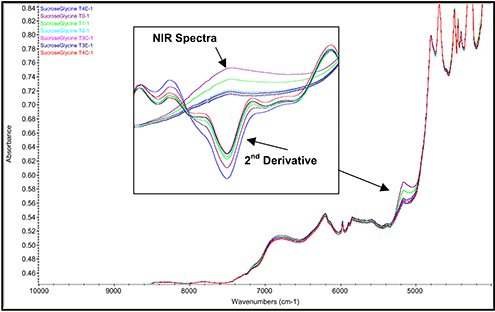
A model was created using partial least square (PLS) technique, constant pathlength, second derivative, Norris smoothing, and spectral regions of 5203.00–5511.56 cm-1and 7112.19–7324.32 cm-1. The KF moisture value and the average predicated moisture value from the calibration were compared to check performance of the correlation model. See Figure 1 for example NIR spectra and second derivative spectra and Figure 2 for comparison of KF and NIR predicted moisture results. All predicted results were within ± 0.2 % H2O (absolute difference) of the KF result, except for Vial 3, which was atypically high. The curve created would be most suitable for moisture levels between 1% and 4% based on the data points used to create the curve. Vial 3 was more than 6% moisture and did not fit the curve as well (absolute difference was 0.7% H2O).
Case study: small-molecule lyophilized product
A new residual moisture method was required for a small-molecule product containing ascorbic acid (vitamin C) and mannitol. Previous efforts had utilized coulometric KF and direct addition of the solid to the titrator with unacceptable results. Ascorbic acid is known to interfere with iodine in KF reaction (Equation 4):
C6H8O6 + I2 → C6H6O6 + 2I-
[Eq. 4]
This interference may yield falsely high results, because the ascorbic acid is measured as water by the titrator and may be contributing to high variability of moisture results using the current method. Therefore, a new method for moisture analysis was developed to minimize exposure of the lyophilized product to ambient humidity and improve the accuracy and precision of sample data.
Various techniques for moisture analysis were evaluated with samples to evaluate compatibility with each method type. Samples were prepared for evaluation to contain varying levels of ascorbic acid while keeping other drug product ingredient levels constant, to confirm any impact of ascorbic acid interference on the results. Samples were equilibrated for a few days with stoppers removed in a desiccator filled with saturated potassium hydroxide (KOH) having a relative humidity of approximately 8.2% to ensure that all vials were equivalent in moisture prior to testing. Vials were stoppered after equilibration under conditions of low humidity (approximately 20%) in a nitrogen-purged glove box.
Samples were analyzed by KF using anhydrous methanol extraction, KF Oven, and Vapor Pro. LOD was not evaluated as a potential method because it is not specific for moisture analysis. NIR was not pursued at this time due to low projected sample testing requirements. Vials containing the target amount of ascorbic acid were spiked with water to evaluate method accuracy. Only KF Oven and Vapor Pro were used to evaluated spiked samples due to the known interference of ascorbic acid with KF results.
For KF titration, each vial was weighed (w1v) and then reconstituted with 5 mL of anhydrous methanol. The diluent weight was recorded (wd), and the vial was vortex mixed for 30 seconds to mix. Each sample was analyzed in triplicate. The vials were rinsed and dried, and the empty vial weight was obtained (w2v). The moisture of each cake was calculated as shown in Equation 5:

[Eq. 5]
For KF Oven, each sample vial was weighed (w1v), and then reconstituted with 5 mL of anhydrous methanol (wD). Vials were vortex mixed for 30 seconds. Extraction was used with the oven sampler to avoid the interfering ascorbic reaction while also not having to open the product vial containing dried material. Approximately 1 g of this solution was transferred to a KF Oven vial and sealed. Each sample was analyzed in triplicate. Samples were analyzed using an oven temperature of 110 °C, nitrogen flow of 150 mL/min (2.0 psi), mix time of 1800 s, max time of 600 s, and end criteria of ≤ 5 µg/min. The mix time describes the time when the sample vial is lifted into the oven so that moisture begins to be released, but the nitrogen flow is bypassed so the titration does not start yet. The titration begins, nitrogen flows through the sample vial in the oven, and the titration starts. The titration ends when the maximum time or drift rate is reached. Sample vials were rinsed, dried, and weighed (w2v). The moisture of each cake was calculated as above, using a vial filled with anhydrous methanol for a blank.
For Vapor Pro, each sample vial was weighed (w1vg). The lyophilized cake was broken up using a sample breaker (needle-like tool inserted through the stopper). Each vial was analyzed using a temperature setting of 110 °C and a nitrogen flow of 75 ± 2 mL/min. Stop criteria for the analysis included a minimum time of 10 minutes, followed by a rate criteria of ≤ 0.05 µg/s. After analysis, the vial was rinsed, dried, and weighed (w2vg). The percent moisture of each cake was calculated by dividing the amount of water measured by the weight of the sample cake, in other words, (µg water/(w1v– w2v)) x (1 g/106 µg) x 100. The entire vial is analyzed at once for Vapor Pro.
Figure 3. Summary of Karl Fischer (KF) moisture results for samples with varying ascorbic acid levels.
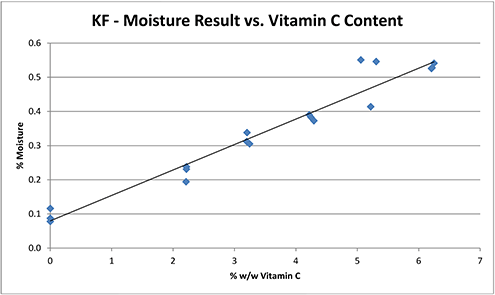
Samples analyzed by KF using anhydrous methanol extraction were difficult to dissolve in methanol and showed a proportional increase in apparent residual moisture with respect to increase in ascorbic acid (Figure 3) demonstrating that KF is not suitable for the product.
Samples analyzed by KF oven with anhydrous methanol extraction were quite variable and even negative, likely due to very low moisture levels in the product which may have been below the sensitivity of the instrument (Figure 4). No trend in moisture relative to ascorbic acid content was observed. A diaphragm-less cathode must be used for KF oven instruments, which impacts instrument sensitivity. Samples analyzed by Vapor Pro showed improved precision and no trend in moisture related to ascorbic acid content (Figure 5).
Figure 4. Summary of Karl Fischer (KF) oven with anhydrous methanol extraction moisture results for samples with varying ascorbic acid levels.
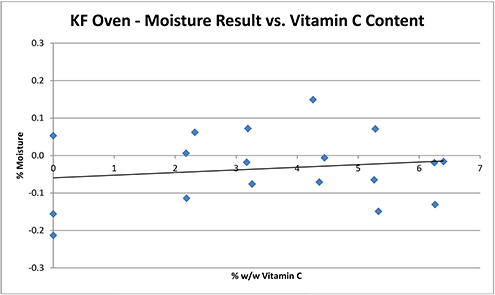
The spiking study for the KF oven using anhydrous methanol showed that results were linear (R2 = 1.00), but not as accurate as expected (Figure 6). All recoveries were near 75%, supporting that some aspect of the spiking technique or measurement technique was impacting the result. Spiking of the methanol diluent instead of direct addition of water to the sample has been performed with success for other KF accuracy studies and may yield improved accuracy results here as well. Precision for triplicate measurements was acceptable at 2–11% (Table II).
Figure 5. Summary of Vapor Pro moisture results for samples with varying ascorbic acid content.
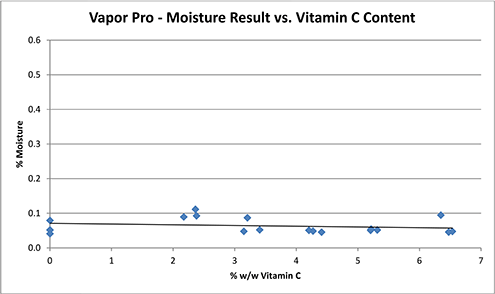
The spiking study for Vapor Pro showed that Linearity was acceptable (R2 = 1.00), and accuracy was also acceptable with recoveries of 92–104% (Figure 7 and Table III). Precision could not be evaluated because only one vial was analyzed at each level, but previous Vapor Pro studies demonstrated acceptable precision.
Figure 6. Summary of Karl Fischer (KF) oven spiking study results in anhydrous methanol diluent.
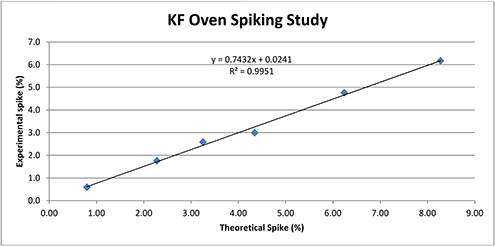
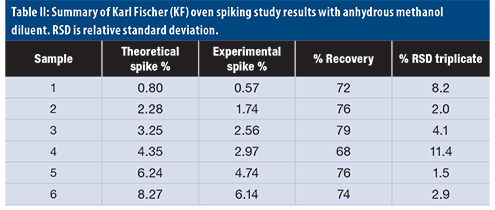
Though the Vapor Pro method demonstrated better precision, accuracy, and linearity than the KF Oven method, additional method optimization and evaluation were performed for the KF Oven method in an effort to yield a suitable method that complied with USP <921>.
An extraction solvent consisting of anhydrous methanol:formamide (2:1) with KF oven analysis was found to yield more consistent results for samples, indicating that the samples may not have dissolved well in previous KF oven testing, leading to falsely low residual moisture values. The anhydrous methanol:formamide (2:1) mixture was used to repeat a spiking study for the KF oven. Sample vials were equilibrated to constant humidity, and approximate moisture levels were evaluated by NIR before spiking to ensure that spectra for each vial matched.
Figure 7. Summary of Vapor Pro spiking study results.

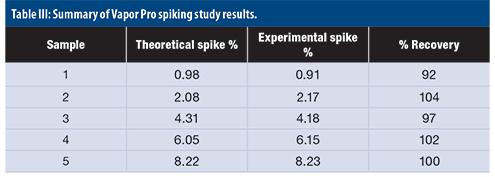
The repeat spiking study for KF oven with anhydrous methanol:formamide (2:1) diluent was assessed for recovery/accuracy, precision, and linearity. Moisture for an unspiked sample was used to determine the spike recoveries for each level. Spike recoveries ranged from 95–127%. Precision ranged from 6–17%. Linearity was evaluated by plotting the experimental spike recovery vs. the theoretical spike recovery. Linearity was demonstrated, with an R2 value of 0.99 (Table IV, Figure 8).
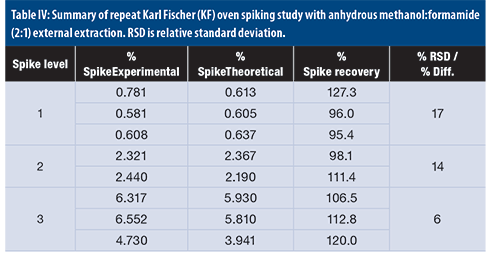
Figure 8. Plot of repeat Karl Fischer (KF) oven spiking study using anhydrous methanol:formamide (2:1) extraction solvent.
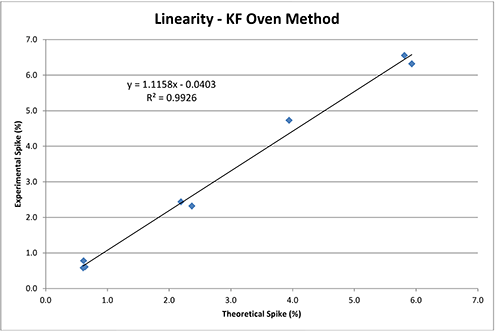
For this case study, suitable Vapor Pro and KF oven methods were developed for residual moisture analysis of the drug product containing mannitol and ascorbic acid (Table V). Method validation would be required prior to using either method for testing for GMP purposes. Ultimately, the KF oven method was chosen using the anhydrous methanol:formamide (2:1) diluent because this technique is described in USP <921>, Method 1c (9).
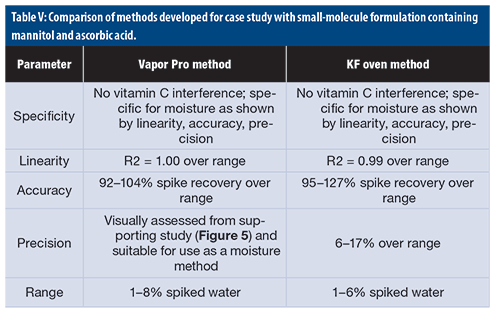
Conclusion
Residual moisture is a critical attribute of lyophilized drug product formulations, and suitable methods must be developed to accurately measure residual moisture for drug product characterization and stability. Methods should be specific for water, and coulometric KF, NIR, and emerging techniques such as Vapor Pro are favored over non-specific methods such as LOD and TGA.
Method development must include evaluation of interfering reactions and sample solubility for KF methods and potential for heat degradation for oven methods. Sample analysis from an unopened lyophilized vial is preferable, and creation of a NIR calibration curve should be considered for larger projects where the additional work would be a worthwhile investment in the long term. All methods should be validated prior to use for GMP testing, including spike recovery studies.
References
1. J. Towns, “Moisture Content in Proteins: Its Effects and Measurement,” Journal of Chromatography A, 705 (1) 115–127 (1995).
2. M. Savage, “Determination of Adequate Moisture Content for Efficient Dry-Heat Viral Inactivation in Lyophilized Factor VIII by Loss on Drying and by Near Infrared Spectroscopy,” Biologicals, 26 (2) 119–124 (1998).
3. USP <1241>, “Water-Solid Interactions in Pharmaceutical Systems” (US Pharmacopeial Convention, Rockville, MD, 2019).
4. J. May, Journal of Biological Standardization, 10 (3) 249–259 (1982).
5. USP <731>, “Loss on Drying” (US Pharmacopeial Convention, Rockville, MD, 2019).
6. USP <891>, “Thermal Analysis” (US Pharmacopeial Convention, Rockville, MD, 2019).
7. S. MacLeod, Analytical Chemistry 63 (10) 557–566 (1991).
8. Mettler Toledo, “Fundamentals of the Coulometric Karl Fischer Titration with Selected Applications,” Mettler Toledo Titrators DL32/DL39 Applications Brochure 32 (2002)
9. USP <921>, “Water Determination” (US Pharmacopeial Convention, Rockville, MD, 2019).
10. Metrohm, “Water Determination by Karl Fischer Titration,” Metrohm Monograph 8.026.5013 (2003).
11. T. Lin, PDA Journal of Pharmaceutical Science and Technology 56 (4) 196–205 (2002).
12. USP <1119>, “Near-Infrared Spectroscopy” (US Pharmacopeial Convention, Rockville, MD, 2019).
About the author
Elizabeth Joseph is research scientist II, BioPharma Solutions at Baxter Healthcare Corporation.
Article Details
Pharmaceutical Technology
Vol. 43, No. 11
November 2019
Pages: 30–39, 56
Citation
When referring to this article, please cite it as E. Joseph, “Residual Moisture Determination in Lyophilized Drug Products,” Pharmaceutical Technology 43 (11) 2019.
